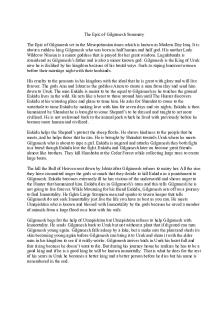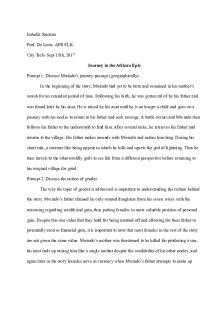The Epic of Gilgamesh – Prompt 1 PDF

| Title | The Epic of Gilgamesh – Prompt 1 |
|---|---|
| Course | Readings in World Literature - 1 |
| Institution | University of Chicago |
| Pages | 3 |
| File Size | 99.4 KB |
| File Type | |
| Total Downloads | 6 |
| Total Views | 160 |
Summary
The Epic of Gilgamesh essay...
Description
The Epic of Gilgamesh – Prompt 1 Repetitive parallelism and incremental repetition are two features that are extensively used in the Epic of Gilgamesh. Repetition is often by different voices and so it shows the various perspectives of the characters for different events. The repetition also serves as a tool for emphasis or to show a change that has occurred between the first and the successive appearances of the particular stanza in the epic. Gilgamesh’s exploration of emotional maturation is explicated by the change in his perspective in the repetition of the opening lines of the text at the end of the epic. “Climb Uruk’s wall and walk back and forth! Survey its foundations, examine the brickwork! Were its bricks not fired in an oven? Did the Seven Sages not lay its foundations?”1 The first time we read these lines, they appear to be purely descriptive, with no action, and set the stage for the story. The language is lucid. The opening stanza is described in the narrator’s voice whereas the closing stanza is in Gilgamesh’s voice as he introduces his city to Ur-shanabi. The significance of the epic beginning and ending with the same stanza is that it represents Gilgamesh’s viewing Uruk in a new light. The story completing a circle is an aesthetic choice to represent the cyclical nature of life.
The earlier Gilgamesh is depicted as a tyrannical ruler, taking advantage of his subjects to please his own whims and fancies. After meeting Enkidu, he realizes the importance of society over living individually for oneself. Gilgamesh’s journey follows the pattern of the Hero’s Journey Monomyth2, involving a ‘departure’ when Gilgamesh goes along with Enkidu to kill Humbaba; an ‘initiation’ when Gilgamesh embarks upon a second journey to find Uta-napishti and gain the secret to immortality after Enkidu’s death; and a ‘return’ when Gilgamesh returns to Uruk, without the
secret to immortality, however still successful in his mission because he is liberated from the fear of death and learns to live in the moment. The transformed Gilgamesh that returns to Uruk has come to terms with his mortality. He has already immortalized himself through his deeds when he kills Humbaba and the Bull of Heaven and also by building the city of Uruk.
The ‘realization upon return’ is an archetypal structure in many modern works. Gilgamesh leaves Uruk to look for immortality but when he returns he realizes that what he was looking for was right in front of him. Uruk is Gilgamesh’s legacy. The opening lines create a sense of how long lasting the city’s structure is and its fortitude. The repetition of the lines carries additional meaning at the end. The Seven Sages are connected to Humbaba as they are the auras surrounding him. When Gilgamesh kills Humbaba, he also destroys the Seven Sages, the forces that originally built his city. The repetition carries the weight of this knowledge.
As stated in the thesis, the repetition at the ending of the epic points to a major change in Gilgamesh’s view on life. Through his emotional exploration of the meaning of life, Gilgamesh learns to be comforted by the fact that even though individual men will die; mankind will continue to exist. He understands the power and reality of Death and reaches reflective maturity. He experiences symbolic rebirth. The ending of the story is like a second beginning; this is reinforced by the fact that the story is left open-ended. Gilgamesh embarks on the journey of the second stage of his life with a new mindset. He completes the first circle of his journey involving plan, action, failure and lesson and now he is on a new arc. The readers are also faced with the fact that maturity can be gained as much through failure as through success.
Bibliography
1) George, A. R. "Tablet 1." The Epic of Gilgamesh: The Babylonian Epic Poem and Other Texts in Akkadian and Sumerian. N.p.: Penguin Classics, n.d. 2+. Print.
2) "Campbell's 'Hero's Journey' Monomyth." Campbell's 'Hero's Journey' Monomyth. N.p., n.d. Web. 08 Oct. 2016. ....
Similar Free PDFs

The Epic of Gilgamesh – Prompt 1
- 3 Pages

The Epic of Gilgamesh - homework
- 1 Pages

Epic of Gilgamesh Essay
- 3 Pages

The Epic of Gilgamesh Summary
- 1 Pages

30 - Epic of Gilgamesh excerpt
- 4 Pages

Physics writing prompt 1
- 25 Pages

Journey in the African Epic
- 3 Pages

Essay 1 Prompt
- 2 Pages
Popular Institutions
- Tinajero National High School - Annex
- Politeknik Caltex Riau
- Yokohama City University
- SGT University
- University of Al-Qadisiyah
- Divine Word College of Vigan
- Techniek College Rotterdam
- Universidade de Santiago
- Universiti Teknologi MARA Cawangan Johor Kampus Pasir Gudang
- Poltekkes Kemenkes Yogyakarta
- Baguio City National High School
- Colegio san marcos
- preparatoria uno
- Centro de Bachillerato Tecnológico Industrial y de Servicios No. 107
- Dalian Maritime University
- Quang Trung Secondary School
- Colegio Tecnológico en Informática
- Corporación Regional de Educación Superior
- Grupo CEDVA
- Dar Al Uloom University
- Centro de Estudios Preuniversitarios de la Universidad Nacional de Ingeniería
- 上智大学
- Aakash International School, Nuna Majara
- San Felipe Neri Catholic School
- Kang Chiao International School - New Taipei City
- Misamis Occidental National High School
- Institución Educativa Escuela Normal Juan Ladrilleros
- Kolehiyo ng Pantukan
- Batanes State College
- Instituto Continental
- Sekolah Menengah Kejuruan Kesehatan Kaltara (Tarakan)
- Colegio de La Inmaculada Concepcion - Cebu







